Imbolc New Life Moon
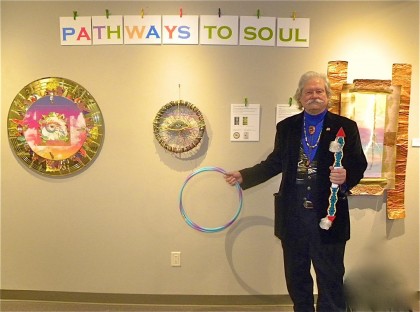
Friend Jim Johnson had an opening of his work in Aberdeen, South Dakota the other night. His new work is lots of colors, strings, leaves, nice bright colors as Simon and Garfunkel sang. Jim, and his long time friend Mark, have both taken their art with them into the third phase. Mark has written one book, an initiation tale, about his time in Vietnam and is at work on another, a hero’s quest tale of his time in Fiji and on the road. He also had a show of new work a couple of years ago, his bridge series. I admire them, keeping Bridgit’s hearthfire lit. Life opens forward if you let it.
Bridgit is the triple goddess in the auld Celtic faith, patroness of poetry, of song, of craft, of the creative spirit. At the double monastery in Kildare, Ireland (men and women), Christians kept her eternal fire burning even after the church absorbed her as a saint. This is Bridgit’s time. She’s the goddess of Imbolc, the cross quarter holiday when the magic of life in the womb brought hope to ancient Celts after the long fallow season.

This is my creed outworn (see Wordsworth in the post below). Or, part of it. James Hillman, a very interesting Jungian analyst, said we find the gods in our pathologies. I believe that, too. Jung said we find the gods in our diseases. I believe we find them, too, in passions, in new art, in turning over old life like a furrow in which to plant the divine seeds of a new one.
A while back I talked about doing the work that only I can do. Jim and Mark are doing theirs. Over the last few weeks, reading Emerson and Deng Ming-Dao in daily meditations, I’ve found resonance with this idea. Emerson said, for example, in his essay, Success, “Each (person) has an aptitude born with (them). Do your work…It is rare to find a (person) who believes their own thought or who speaks that which (they were) created to say.” Ming-Dao, in his 365 Days of the Tao, says, in his entry #40, subconscious: “Everything to be understood is within us. All that must be transcended…is within us. All the power of transcendence is within us. Tap into it and you tap into the divine itself.”
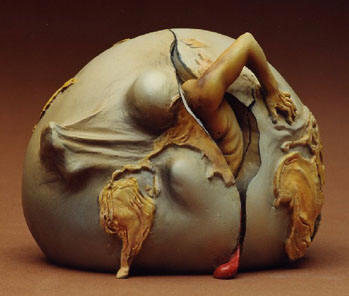 It is axiomatic that each person is unique, a particular example of the human, of life, of the creative process that began at tzimtzum or the big bang, thrown into a particular time and a particular place. It is that particularity that Emerson elevates. It is that particularity which formulates within us, as instantiations of the whole, our own work. When we tap into the sacred, the shard of ohr (divine light) lodged within us, we come to know our work. And, the world needs it because you are the only one with this spark of the divine and the only one in the whole history of the universe who has it. If you don’t express your ancientrail, it will die with you and the world will be poorer.
It is axiomatic that each person is unique, a particular example of the human, of life, of the creative process that began at tzimtzum or the big bang, thrown into a particular time and a particular place. It is that particularity that Emerson elevates. It is that particularity which formulates within us, as instantiations of the whole, our own work. When we tap into the sacred, the shard of ohr (divine light) lodged within us, we come to know our work. And, the world needs it because you are the only one with this spark of the divine and the only one in the whole history of the universe who has it. If you don’t express your ancientrail, it will die with you and the world will be poorer.
We need you. As you are. Not as a bearer of tradition. Not as a follower of rules and laws, no matter what their claim to authority. Not as a sycophant to the culture in which you were raised. No, none of these. Instead we need the you that dances among the stars, the you that drinks from the deep holy wells within you. We need the you that only you can be.
Yes, it’s a scary prospect that you might be worthwhile just for what you are. Not for the degrees you’ve earned or the children you’ve had or the job you do, but for the you that carries a singular vision, a once in eternity vantage point on the universe. Tell us what you see. Tell us what you know. Tell us who you are. We need you, all of us need you.

 Worlds collided last night and I found it unpleasant. Rabbi Jamie, the Evergreen Chorale, and choir director Val Robinson combined for an evening of Jospel music. That’s gospel music done in a Jewish idiom. Val was a spectacular director. She had the choir energized, crisp in its delivery, and used all of its members as if she were playing an organ. A Beth Evergreen member, Cheri Rubin and her husband Alan, helped make this happen.
Worlds collided last night and I found it unpleasant. Rabbi Jamie, the Evergreen Chorale, and choir director Val Robinson combined for an evening of Jospel music. That’s gospel music done in a Jewish idiom. Val was a spectacular director. She had the choir energized, crisp in its delivery, and used all of its members as if she were playing an organ. A Beth Evergreen member, Cheri Rubin and her husband Alan, helped make this happen. I didn’t realize the distance I’d come from Alexandria and the gospel music style of
I didn’t realize the distance I’d come from Alexandria and the gospel music style of  The first day of Lent falls, this year, today. That means, as Allan Metcalf, the author of the article quoted below says, that we’re dealing with hearts and ashes. Makes sense to me that my 71st would fall on such a day. Since hitting three score and ten a year ago, I’ve passed into birthdays that commonly show up in the obituary pages. Ash Wednesday reminds us that we deconstruct, returning our enlivened elements. #Recycle Me as the green burial folks said.
The first day of Lent falls, this year, today. That means, as Allan Metcalf, the author of the article quoted below says, that we’re dealing with hearts and ashes. Makes sense to me that my 71st would fall on such a day. Since hitting three score and ten a year ago, I’ve passed into birthdays that commonly show up in the obituary pages. Ash Wednesday reminds us that we deconstruct, returning our enlivened elements. #Recycle Me as the green burial folks said.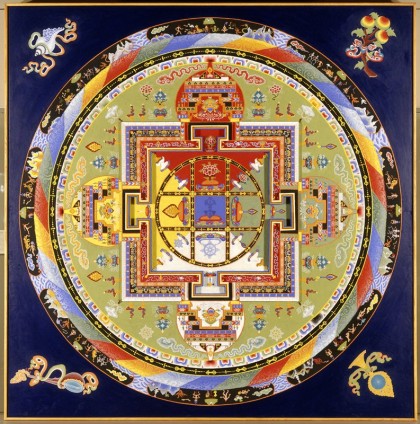

 I don’t miss the heavy lifting (the literal heavy lifting) for the most part, though part of my time at Beth Evergreen involves setting up for Adult Ed events and I do like moving chairs and tables, that sort of thing. Go figure. But I also need purposeful, intellect engaged physical activity. Different from exercise, which I also need. Cooking is physical and intellectual, also creative.
I don’t miss the heavy lifting (the literal heavy lifting) for the most part, though part of my time at Beth Evergreen involves setting up for Adult Ed events and I do like moving chairs and tables, that sort of thing. Go figure. But I also need purposeful, intellect engaged physical activity. Different from exercise, which I also need. Cooking is physical and intellectual, also creative. The sumi painting I’ve not yet fully engaged, still collecting materials, setting up my work space, learning techniques, but I intend to stay at it as long as it takes to get some proficiency. Precise or artistic hand work has never been my thing, but I’m going to change that, at least to some degree.
The sumi painting I’ve not yet fully engaged, still collecting materials, setting up my work space, learning techniques, but I intend to stay at it as long as it takes to get some proficiency. Precise or artistic hand work has never been my thing, but I’m going to change that, at least to some degree. “The more I have looked into the Quest for the Grail, it is clear it is a Western form of Zen. There is no grail, it is understanding that the veil is the mystery of existence, it is nothing, but our interactions with everyone and everything.” Woolly and friend, Mark Odegard
“The more I have looked into the Quest for the Grail, it is clear it is a Western form of Zen. There is no grail, it is understanding that the veil is the mystery of existence, it is nothing, but our interactions with everyone and everything.” Woolly and friend, Mark Odegard

 The Woolly Mammoths have been my companions, fellow pilgrims, on the way to Canterbury. Or, fellow Tibetan Buddhists inch worming their way around the sacred mountain, Meru. Or, my fellow Torah scholars, davening as we read the sacred texts. Or, fellow Lakotas, our skin pierced and tied to the world tree during the Sun Dance. Or, friends traveling through this life together until it ends.
The Woolly Mammoths have been my companions, fellow pilgrims, on the way to Canterbury. Or, fellow Tibetan Buddhists inch worming their way around the sacred mountain, Meru. Or, my fellow Torah scholars, davening as we read the sacred texts. Or, fellow Lakotas, our skin pierced and tied to the world tree during the Sun Dance. Or, friends traveling through this life together until it ends.


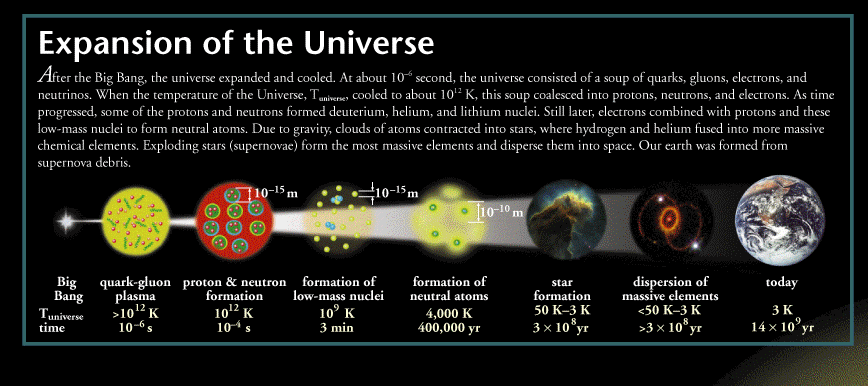 No. God is another word for the intimate linkage between and among all things, from the smallest gluon to the largest star. God is neither a superparent nor a cosmic Santa Claus writing down your behaviors in the book of deeds; God is a metaphor for the sacred knowledge which permeates the perceivable, and the unperceivable, world.
No. God is another word for the intimate linkage between and among all things, from the smallest gluon to the largest star. God is neither a superparent nor a cosmic Santa Claus writing down your behaviors in the book of deeds; God is a metaphor for the sacred knowledge which permeates the perceivable, and the unperceivable, world.

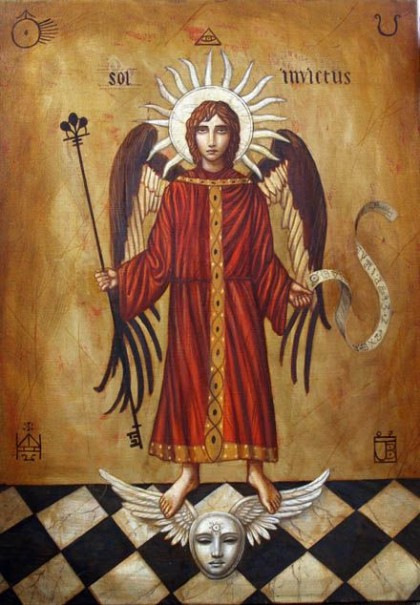 The solstices mark swings to and from extremes, from the longest day to the longest night, there, and as with Bilbo, back again. Darkness and light are never steady in their presence. The earth always shifts in relation to the sun, gradually lengthening the days, then the nights.
The solstices mark swings to and from extremes, from the longest day to the longest night, there, and as with Bilbo, back again. Darkness and light are never steady in their presence. The earth always shifts in relation to the sun, gradually lengthening the days, then the nights.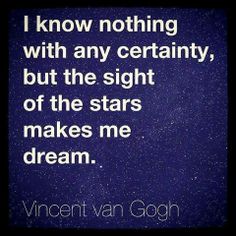 In these long nights the cold often brings clear, cloudless skies. The wonderful Van Gogh quote that I posted a few days ago underscores a virtue of darkness, one we can experience waking or asleep. Dreaming takes us out of the rigors of day to day life and puts us in the realm where ideas and hopes gather. So, the lengthening of the nights increases our opportunity to experience dream time. Whether you believe in Jung’s collective unconscious or not-I do, the rich resources of dreaming are available to us with greater ease when the nights are long and the cold makes sleeping a joy.
In these long nights the cold often brings clear, cloudless skies. The wonderful Van Gogh quote that I posted a few days ago underscores a virtue of darkness, one we can experience waking or asleep. Dreaming takes us out of the rigors of day to day life and puts us in the realm where ideas and hopes gather. So, the lengthening of the nights increases our opportunity to experience dream time. Whether you believe in Jung’s collective unconscious or not-I do, the rich resources of dreaming are available to us with greater ease when the nights are long and the cold makes sleeping a joy.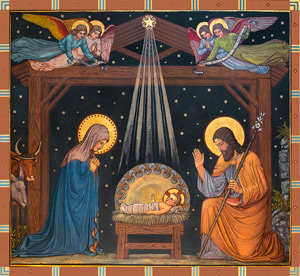

 CC’s work with Maslow sparked a conversation about the difference between human agency in moving up the pyramid as opposed to the necessity of God’s agency. Within my worldview this is a false dichotomy, but the conversation was fruitful. It’s a false dichotomy to me for two reasons. 1. How else would God move someone up the pyramid save through human agency? 2. Since I see energy moving up and down the tree of life, from the invisible to the visible and back through the visible to the invisible, this energy flow is the key agency involved, imh. I might call it chi, or prana, or l’chaim. Could also call it divine or vitality or consciousness. I don’t see that adding God to the conversation accomplishes much.
CC’s work with Maslow sparked a conversation about the difference between human agency in moving up the pyramid as opposed to the necessity of God’s agency. Within my worldview this is a false dichotomy, but the conversation was fruitful. It’s a false dichotomy to me for two reasons. 1. How else would God move someone up the pyramid save through human agency? 2. Since I see energy moving up and down the tree of life, from the invisible to the visible and back through the visible to the invisible, this energy flow is the key agency involved, imh. I might call it chi, or prana, or l’chaim. Could also call it divine or vitality or consciousness. I don’t see that adding God to the conversation accomplishes much. In the end I felt heard and honored for my understanding of the relationship between the cyclical turn of the seasons and the meaning of the tree of the life to kabbalists.
In the end I felt heard and honored for my understanding of the relationship between the cyclical turn of the seasons and the meaning of the tree of the life to kabbalists. Since I have long believed that the world’s religions are philosophy and poetry accessible to all, I remain eager to learn from them. Since I know their claims cannot all be true, I choose to remain outside them, yet to walk with them as part of my journey. During college, when fellow students were turning to Asian faiths: the hare krishnas, zen, tibetan mysticism, I believed that the religious traditions of the West were most culturally attuned to the American mind. I still believe that and find Judaism and its traditions and thoughts, like Christianity, trigger a depth of understanding I don’t get from the Asian faiths.
Since I have long believed that the world’s religions are philosophy and poetry accessible to all, I remain eager to learn from them. Since I know their claims cannot all be true, I choose to remain outside them, yet to walk with them as part of my journey. During college, when fellow students were turning to Asian faiths: the hare krishnas, zen, tibetan mysticism, I believed that the religious traditions of the West were most culturally attuned to the American mind. I still believe that and find Judaism and its traditions and thoughts, like Christianity, trigger a depth of understanding I don’t get from the Asian faiths. Think I’ve figured out my kabbalah presentation. Still a bit rough around the edges but that’s going to be part of it. It’ll be a how to think with the tree of the life as a touchstone example, using the Great Wheel as an instance.
Think I’ve figured out my kabbalah presentation. Still a bit rough around the edges but that’s going to be part of it. It’ll be a how to think with the tree of the life as a touchstone example, using the Great Wheel as an instance.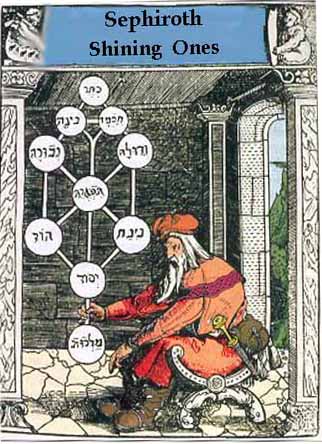 This a crucial difference between a secular, scientific world view and a mystical one. Entropy posits, as I mentioned in a post not long ago, that all things die, including death, I suppose. The Great Wheel and the tree of life challenge that grim metaphysics with an alternative.
This a crucial difference between a secular, scientific world view and a mystical one. Entropy posits, as I mentioned in a post not long ago, that all things die, including death, I suppose. The Great Wheel and the tree of life challenge that grim metaphysics with an alternative.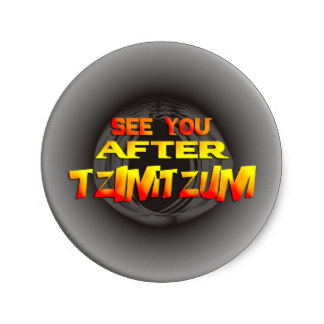 God became fractionated during the tzimtzum, the contraction of divine energy that made the finite possible. This idea is still difficult for me, but I’m just accepting it for the purposes of this presentation. During the tzimtzum the infinite light, ohr, tried to manifest in the finite, filling the space created by the contraction, but the vessel, things, (ein sof = no-things, infinity) could not hold it and shattered. That shattering created all the elements that now make up our universe. (and other universes, too) Trapped inside all of these elements is the ohr. The ascent and descent of divine energy, from the keter to malchut and backup through the sephirot to the keter from malchut, is the way the ohr will once again join with the infinite. How? No clue.
God became fractionated during the tzimtzum, the contraction of divine energy that made the finite possible. This idea is still difficult for me, but I’m just accepting it for the purposes of this presentation. During the tzimtzum the infinite light, ohr, tried to manifest in the finite, filling the space created by the contraction, but the vessel, things, (ein sof = no-things, infinity) could not hold it and shattered. That shattering created all the elements that now make up our universe. (and other universes, too) Trapped inside all of these elements is the ohr. The ascent and descent of divine energy, from the keter to malchut and backup through the sephirot to the keter from malchut, is the way the ohr will once again join with the infinite. How? No clue. This is a malchutian manifestation, I think, of the ascent and descent and ascent again of divine energy represented by the tree of life. Why? Well, until the divine energy passes through yesod and becomes real in malchut, it is hidden, invisible, just like the vivifying function of the soil and the air and the sun is hidden during the fallow time. Both represent the cyclical nature of things coming into existence from apparent no-thing, then returning themselves to the invisible, the hidden.
This is a malchutian manifestation, I think, of the ascent and descent and ascent again of divine energy represented by the tree of life. Why? Well, until the divine energy passes through yesod and becomes real in malchut, it is hidden, invisible, just like the vivifying function of the soil and the air and the sun is hidden during the fallow time. Both represent the cyclical nature of things coming into existence from apparent no-thing, then returning themselves to the invisible, the hidden.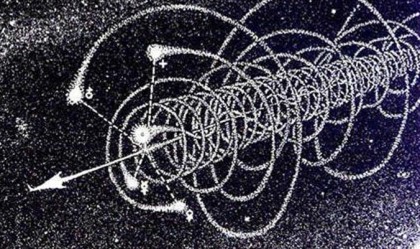 The slinkys I will hand out, tiny one-inch ones, illustrate what I mean. The Great Wheel turns through one year, one orbit around the sun, then repeats and is, in that, cyclical and not chronological. But, if you link this orbit to that one we get a spiral as our rapidly moving planet follows our solar system around the galaxy at unimaginable rates of speed. The Great Wheel then extends in space, in a spiral, this year’s revolution becoming another while the whole planet and its sun captive neighbors push further and further around the Milky Way. And, just to add complexity, as the whole galaxy moves, too.
The slinkys I will hand out, tiny one-inch ones, illustrate what I mean. The Great Wheel turns through one year, one orbit around the sun, then repeats and is, in that, cyclical and not chronological. But, if you link this orbit to that one we get a spiral as our rapidly moving planet follows our solar system around the galaxy at unimaginable rates of speed. The Great Wheel then extends in space, in a spiral, this year’s revolution becoming another while the whole planet and its sun captive neighbors push further and further around the Milky Way. And, just to add complexity, as the whole galaxy moves, too.